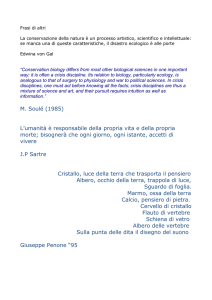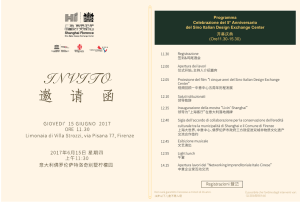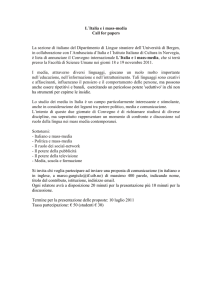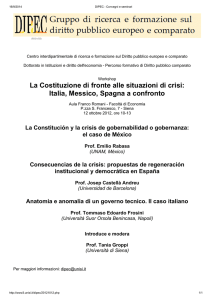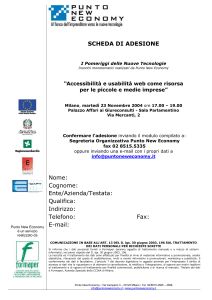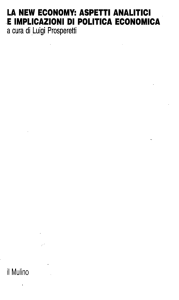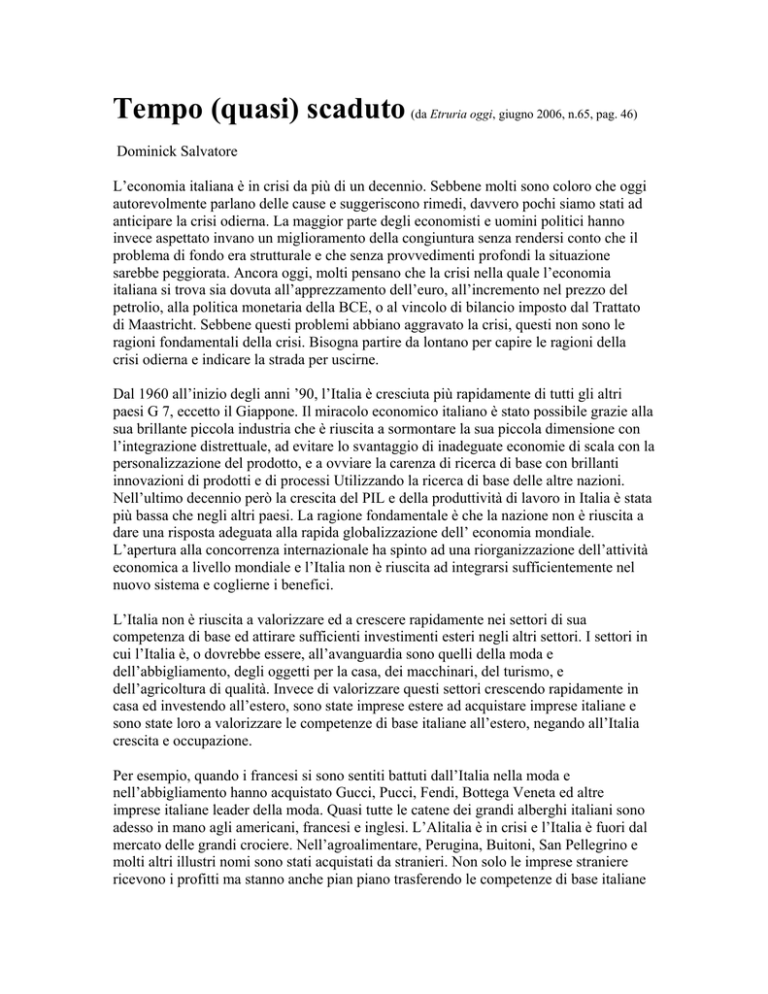
Tempo (quasi) scaduto (da Etruria oggi, giugno 2006, n.65, pag. 46)
Dominick Salvatore
L’economia italiana è in crisi da più di un decennio. Sebbene molti sono coloro che oggi
autorevolmente parlano delle cause e suggeriscono rimedi, davvero pochi siamo stati ad
anticipare la crisi odierna. La maggior parte degli economisti e uomini politici hanno
invece aspettato invano un miglioramento della congiuntura senza rendersi conto che il
problema di fondo era strutturale e che senza provvedimenti profondi la situazione
sarebbe peggiorata. Ancora oggi, molti pensano che la crisi nella quale l’economia
italiana si trova sia dovuta all’apprezzamento dell’euro, all’incremento nel prezzo del
petrolio, alla politica monetaria della BCE, o al vincolo di bilancio imposto dal Trattato
di Maastricht. Sebbene questi problemi abbiano aggravato la crisi, questi non sono le
ragioni fondamentali della crisi. Bisogna partire da lontano per capire le ragioni della
crisi odierna e indicare la strada per uscirne.
Dal 1960 all’inizio degli anni ’90, l’Italia è cresciuta più rapidamente di tutti gli altri
paesi G 7, eccetto il Giappone. Il miracolo economico italiano è stato possibile grazie alla
sua brillante piccola industria che è riuscita a sormontare la sua piccola dimensione con
l’integrazione distrettuale, ad evitare lo svantaggio di inadeguate economie di scala con la
personalizzazione del prodotto, e a ovviare la carenza di ricerca di base con brillanti
innovazioni di prodotti e di processi Utilizzando la ricerca di base delle altre nazioni.
Nell’ultimo decennio però la crescita del PIL e della produttività di lavoro in Italia è stata
più bassa che negli altri paesi. La ragione fondamentale è che la nazione non è riuscita a
dare una risposta adeguata alla rapida globalizzazione dell’ economia mondiale.
L’apertura alla concorrenza internazionale ha spinto ad una riorganizzazione dell’attività
economica a livello mondiale e l’Italia non è riuscita ad integrarsi sufficientemente nel
nuovo sistema e coglierne i benefici.
L’Italia non è riuscita a valorizzare ed a crescere rapidamente nei settori di sua
competenza di base ed attirare sufficienti investimenti esteri negli altri settori. I settori in
cui l’Italia è, o dovrebbe essere, all’avanguardia sono quelli della moda e
dell’abbigliamento, degli oggetti per la casa, dei macchinari, del turismo, e
dell’agricoltura di qualità. Invece di valorizzare questi settori crescendo rapidamente in
casa ed investendo all’estero, sono state imprese estere ad acquistare imprese italiane e
sono state loro a valorizzare le competenze di base italiane all’estero, negando all’Italia
crescita e occupazione.
Per esempio, quando i francesi si sono sentiti battuti dall’Italia nella moda e
nell’abbigliamento hanno acquistato Gucci, Pucci, Fendi, Bottega Veneta ed altre
imprese italiane leader della moda. Quasi tutte le catene dei grandi alberghi italiani sono
adesso in mano agli americani, francesi e inglesi. L’Alitalia è in crisi e l’Italia è fuori dal
mercato delle grandi crociere. Nell’agroalimentare, Perugina, Buitoni, San Pellegrino e
molti altri illustri nomi sono stati acquistati da stranieri. Non solo le imprese straniere
ricevono i profitti ma stanno anche pian piano trasferendo le competenze di base italiane
in questi settori nelle loro nazioni. Investimenti esteri sarebbero molto utili nei settori in
cui l’Italia non ha vantaggi comparati o particolari competenze perché questi portano
nuove tecnologie, più efficienti metodi manageriali, e perché essi permettono una più
profonda integrazione dell’economia italiana nel sistema produttivo mondiale. Spesso in
Italia si parla come se investimenti stranieri fossero da ricercare principalmente perché
portano nuovi capitali. Ma l’Italia non ha carenze di capitali bensì di nuove tecnologie,
nuovi metodi manageriali e di integrazione nell’economia mondiale. Purtroppo, l’Italia
riceve cinque o sei volte meno investimenti esteri dell’Inghilterra e della Francia, la metà
di quelli della piccola Olanda, e molto meno di quelli ricevuti dal Belgio e dalla Spagna.
Le ragioni sono chiare: la situazione del settore pubblico italiano è scandalosa con
eccessivi regolamenti che scoraggiano imprenditori stranieri ad investire in Italia; la
pressione fiscale è più alta che negli altri paesi avanzati, eccetto la Francia; l’Italia è in
fondo alla classifica nella preparazione delle sue forze lavorative in scienza, in
matematica, nella conoscenza della lingua inglese e dell’informatica; e le infrastrutture
sono molto inferiori a quelle degli altri paesi avanzati (per esempio, il costo energetico è
dal 35 a 40 percento superiore a quello degli altri paesi avanzati). Non c’è quindi da
meravigliarsi se l’Italia riceve molti meno investimenti esteri di molte altre nazioni,
eccetto in settori di conquista da parte di imprese straniere.
La crisi economica italiana si riflette negli anemici tassi di crescita (i più bassi dei paesi
dell’UME), nel calo della percentuale delle sue esportazioni nel commercio mondiale,
nella bassissima e decrescente percentuale delle esportazioni di prodotti di alta
tecnologia, nel basso afflusso di investimenti esteri, e nella crisi del settore turistico (la
Spagna riceve Il percento del PIL dal turismo, la Germania 6,5 percento, la Francia 6,2
percento, l’Inghilterra 5,9 percento; l’Italia solo il 5,7 percento). Come risolvere la crisi
competitiva dell’Italia? Con profonde riforme nel settore pubblico, con la riduzione della
pressione fiscale sulle imprese, con la ristrutturazione del mercato del lavoro e dei
servizi, con il miglioramento nella preparazione delle forze lavorative e delle
infrastrutture. E poi non si lavano i panni sporchi all’estero (esempio caso Antonveneta)
perché questo crea un’immagine distorta dell’Italia che scoraggia investimenti esteri e
impone un premio rischio nelle sue relazioni commerciali con gli altri paesi. È vero che è
molto difficile introdurre profonde riforme strutturali quando l’economia non cresce,
anche perché i costi si hanno subito mentre i benefici arrivano con anni di ritardo, ma chi
si illude che aumentando l’età del pensionamento di qualche anno, liberalizzando il
mercato del lavoro in modo marginale, aumentando l’efficienza del settore pubblico di
poco, e facendo una riforma dell’università che sbaglia bersaglio non risolverà i problemi
dell’ economia italiana. Quello che è necessario è una completa ristrutturazione o reengineering di tutta l’economia italiana. Purtroppo, non sembra che ci sia sufficiente
presa di coscienza da parte dei politici di quanto grave la situazione economica sia e
quanti sacrifici siano richiesti per invertire direzione e ridare slancio all’ economia
italiana. Time is running out!
TEMPO (QUASI) SCADUTO—TIME (ALMOST) EXPIRED Translated by Giulio Di
Giacomo
The Italian economy is in crisis for more than a decade. Although many today authoritatively speak about
the causes and suggest remedies, indeed few have been able to anticipate the present crisis. The majority
of the economists and political men have instead waited in vain for an improvement of the economical plight
without realizing that the heart of the problem is structural and that without deep provisions the situation
would be getting worse. Still today, many think that the crisis in which the Italian economy finds itself is due
to the appreciation of the euro, next to the increment in the price of the oil, next to the monetary policy of the
BCE (Central Bank of Europe), or next to the budgetary restriction imposed by the Treaty of Maastricht.
Although these problems have aggravated the crisis, these are not the fundamental reasons or causes of
the crisis. One must look at the situation from afar in order to understand the reasons of the present crisis
and to find the road to come out of it. From 1960 to the beginnig of the ' 90s, Italy has grown more quickly
than all the other countries G 7, except Japan. The Italian economic miracle has been possible thanks to its
shining small businesses that have succeeded in overcoming their small dimensions with district integration,
to avoid the disadvantage of inadequate economies of scale with the personalization of the product, and to
obviate the deficiency of basic research with shining innovations of products and processes using research
findings of other nations. But, in the last decade, the growth of the PIL (U.S. GDP) and the creation of jobs
in Italy have been lower that in the other countries. The fundamental reason is that the nation has not
succeeded in giving an adequate answer to the fast globalization of the world-wide economy. The opening
of the international competition has pushed the reorganization of the economic activity to a world-wide level
and Italy has not succeeded to integrate itself sufficiently in the new system and to extract the benefits. Italy
has not succeeded to valorize and to grow quickly in the fields of its competence and to attract sufficient
foreign investments in the other fields. The fields in which Italy is, or would have to be at the cutting edge,
are those of the fashion and the apparel, of the utensils and implements for the house, the machinery, the
tourism, and agriculture of quality. Instead of valorizing (enhancing in value) these fields, allowing to make
them grow quickly in house and investing abroad, it has been foreign companies to acquire Italian
enterprises and valorizing the Italian competences abroad, denying Italy the economic growth and higher
employment. As an example, when the French felt outdistanced by Italy in the fashion and in the apparel
industry, they acquired Gucci, Pucci, Fendi, Italian Bottega Veneta and other enterprises leaders of the
fashion. Nearly all the chains of the large Italian hotels are now in the hand of the Americans, French and
English. Alitalia is in crisis and Italy is outside of the great cruises market. In the agricultural and nutritional
foods, Perugina, Buitoni, Saint Pellegrino and many other illustrious names have been acquired by
foreigners. Not only the foreign enterprises receive the profits but they are also slowly transferring the basic
Italian competences in these fields to their nations. Foreign investments would be useful in the fields in
which Italy does not have advantages or particular competences in which the foreigners can bring new
technologies, more efficient managerial methods, and because they allow a deeper integration of the Italian
economy in the world-wide productive system. Often in Italy it is believed that foreign investments are
attractive mainly because they bring new capital. But Italy does not have deficiencies of capital but rather of
new technologies, new managerial methods and integration in the world-wide economy. Unfortunately, Italy
receives five or six times less foreign investments than England and France, half the investments received
by the little Holland, and much less than those received by Belgium and Spain. The reasons are clear: the
situation of the Italian public sector is scandalous with excessive regulations that discourage foreign
entrepreneurs to invest in Italy; the fiscal pressure is higher that in the other countries, except France; Italy
is at the bottom of the classification in the education of its working forces in science, mathematics, the
knowledge of the English language and computer science; and the infrastructures are much inferior to those
of other advanced countries (for example, the cost of energy is from 35 to 40 percent higher that of the other
countries). Therefore, one should not be astonished if Italy receives much less foreign investment than
many other nations, except in fields conquered by foreign enterprises. The Italian economic crisis is
reflected in the anemic rates of growth (lowest of the countries of the UME, European Union), in the
decrease of the percentage of its exports in the world-wide commerce, in the lowest and decreasing
percentage of the exports of products of high technology, in the lowest influx of foreign investments, and in
the crisis in tourism (Spain receives 11 percent of the PIL from the tourism, Germany 6.5 percent, France
6.2 percent, England 5.9 percent; Italy only 5,7 percent). How to resolve the competitive crisis of Italy? With
deep reforms in the public sector, with the reduction of the fiscal pressure on the enterprises, with the
restructure of the service and labor market, improvement in the education of the working forces and
infrastructures. And then the dirty clothes are not washed abroad (example, the Antonveneta case) because
this creates a distorted image of the Italy that discourages foreign investments and imposes a prize risk in
its trade relations with the other countries. It is true that it is much more difficult to introduce deep structural
reforms when the economy does not grow, and also because the costs are incurred soon while the benefits
arrive with years of delay, but who is deceived that by increasing the age of the retirement by a year or so,
liberalizing the labor market in marginal way, increasing a little the efficiency of the public sector, and
reforming universities that miss the target will not resolve the problems of the Italian economy. What it is
necessary is a complete restructure or re-engineering of all the Italian economy. Unfortunately, it does not
seem that there is a sufficient grip of conscience on the part of politicians on how serious the economic
situation is and how many sacrifices are required in order to reverse direction and to give again a surge to
the Italian economy. Time is running out!




